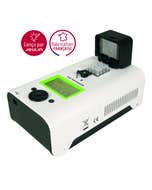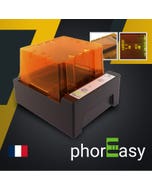Kit Study of the main principles of electrophoresis
Topics covered: - Understanding the main techniques of electrophoresis - Understanding the function of electrophoresis in a scientific approach - Practicing the handling of a micropipette Principles and objectives: Conduct 3 types of experiments with our 12 ready-to-deposit reagents: 1 - Separation based on molecular size The student deposits colored mixtures in the wells. The migration will separate the different components of the deposited reagents. 2 - Separation based on isoelectric point This experiment allows visualizing the true driver of molecule displacement, namely, the characteristics of molecules subjected to an electric field. 3 - Principle of transilluminator and visualization by fluorescence The main observations of the results are made with the naked eye, however, among the reagents used, some also have fluorescent properties under blue light excitation. Using a transilluminator device, explore the concepts of excitation and emission light. The experiment lasts 1 session of 60 minutes (15 minutes per migration). The reagents are provided for 40 pairs (240 deposits, equivalent to 40 3% agarose electrophoresis gels). Composition: 12 tubes of colored reagent mixtures ready to deposit, agarose (19 g), TAE buffer 10X (350 ml equivalent to 3.5 L of TAE 1X) Additional necessary equipment: P20 micropipette and tips, phorEasy electrophoresis ref. 708150 or another horizontal electrophoresis system, transilluminator with blue light source and orange filter. Comments: This practical work covers the basics of how one of the most commonly used tools in molecular biology works. It is suitable for first and second years of higher education who are starting to learn how to handle micropipettes and the basics of electrophoresis.
| Thématique TP | Biologie |








